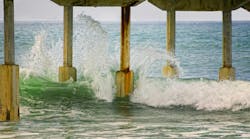The Massachusetts Department of Environmental Protection (MassDEP) has issued draft regulations to provide flood control and prevent storm damage to shorelines: the Massachusetts Waterways Regulation and Wetlands Protection Act Regulations.
MassDEP says that the proposed regulations will help protect areas vulnerable to sea-level rise and storm surge, promote nature-based solutions to flooding, streamline certain permitting processes, and use updated precipitation data to inform decision-making.
The regulations are proposed under the Wetlands Protection Act and the Massachusetts Public Waterfront Act. MassDEP will accept comments on the draft regulations until March 1, 2024.
“We cannot continue a ‘business-as-usual’ approach if we want to build more resilient communities,” said MassDEP Commissioner Bonnie Heiple. “With these regulations, we’ve integrated the latest science and green infrastructure techniques to mitigate climate change impacts and protect residents, municipalities, and businesses from costly rebuilding efforts. MassDEP is grateful for the engagement of stakeholders and agencies in developing this proposal and looks forward to continued feedback on these regulations.”
Coastal and inland flooding resilience
MassDEP says that the proposed Wetlands regulations would promote resilience by creating performance standards to protect the natural buffering function of wetlands and floodplains and help prevent damage to both the natural and built environment.
The standards will require elevation of new development in areas of the coastal floodplain where most storm damage occurs and minimize new development in the most vulnerable area of the coastal floodplain where waves are higher than three feet. The regulations encourage nature-based approaches to improve resilience, such as restoration of salt marshes, coastal dunes, and barrier beaches on the coast, as well as inland wetlands.
Updated stormwater management standards will reduce stormwater pollution to water bodies throughout the state, helping to improve the water quality of our rivers and streams.
The regulations are designed to be flexible for homeowners and families. Single-family homes and housing development with four or fewer units are exempted from the stormwater requirements of the Wetlands regulations and new housing developments with five to nine units per lot must meet new standards only to the extent possible.
Updates to Waterways regulations – which protect and promote public use of tidelands and other waterways in Massachusetts and are commonly known as “Chapter 91” – require license applications to consider projected sea-level rise for certain projects and encourage relocation of building mechanical systems away from the ground floor.
Incentives for nature-based solutions
The Wetlands regulations promote Green Site Design, which uses natural solutions – like trees and buffer zones – to manage stormwater, instead of more expensive detention basins and other traditional infrastructure.
By using nature to address stormwater runoff and pollution, developers will receive Green Site Design credits and will substantially reduce the need to build and maintain more costly stormwater management systems.
Updated precipitation data
The proposed Wetlands amendments use up-to-date data sources to evaluate precipitation – replacing the 1961 data that is currently used with 2019 data from the National Oceanic and Atmospheric Administration. Storms have been increasing in intensity with climate change so that today’s storms deliver more precipitation than they did 60 years ago.
Using outdated data to design stormwater systems means pipes that are too small to carry increased volumes of water – resulting in overflows and flooding.
The switch to data that are more reflective of current conditions will prevent resulting damage to buildings and bridges, scouring of riverbanks, and other problems.
Streamlined permitting
The proposed regulations streamline certain permitting processes.
The Wetlands regulations are updated to align with the EPA Municipal Separate Storm Sewer System General Permit and the Transportation Separate Storm Sewer System Permit to improve consistency and protect surface waters, including wetlands, from stormwater runoff pollution. The Waterways regulations allow modifications to licenses for identified smaller structures (primarily small docks and piers) to account for sea-level rise and maintaining public water access.
MassDEP is accepting public comment on the draft regulations until 5 p.m. on Friday, March 1, 2024.






